Earn Your Master of Science in Athletic Training at Maine’s Leading Health University
The UNE master’s of Athletic Training combines the study of health-related sciences with the art of preventing, managing, and rehabilitating athletic and orthopedic injuries.
Imagine yourself working with elite athletes, providing care under the supervision of world-class health professionals, or treating patients in an athletic injury clinic — all while you’re still a student.
Expert athletic training faculty will guide you through a two-year journey of classes and hands-on learning in our state-of-the-art facilities.
The UNE AT program will help you become a leader in every aspect of improving individual and team wellness.
In addition to the traditional 24-month Athletic Training master’s degree, UNE also offers a 3+2 B.S./M.S.A.T., for students seeking to complete their undergraduate and graduate work within an integrated five-year track.
of UNE M.S.A.T. students were placed in their top choice for immersive clinical rotation
Why UNE for your Master of Science in Athletic Training
Gain vital experience collaborating by studying at a leading health professions university, right on the coast of Maine.
- Learn alongside students from UNE’s medical school, studying in gross anatomy lab and providing side-by-side patient care in our on-campus Injury Care Clinic.
- By studying with other aspiring health professionals including students of nursing, PT, OT and other programs, you'll learn to collaborate in today’s team-based health care.
- Experience wide-ranging clinical opportunities in areas such as pro sports, college athletics, orthopedic clinics, primary care medicine, and graduate research.
- Learning happens in state-of-the-art teaching and research laboratories. The AT program sits in the center of UNE’s 105,000 square-foot athletics complex, providing access to facilities and teams.
- UNE’s world-class instructors lead you through a rigorous, forward-thinking curriculum.
What will you study? Athletic Training Curriculum Overview
Our curriculum combines the study of anatomy and other health-related sciences with the art of preventing, managing, and rehabilitating athletic and orthopedic injuries.
Tracks and Degrees
UNE offers a two-year M.S.A.T. degree for those with a B.S. who meet all prerequisites, as well as a 3+2 Athletic Training track for high school graduates seeking to earn their B.S. and M.S. degrees in five years.
Curriculum
| Program Required Courses | Credits |
|---|---|
| ATC 500 – Fundamentals of Athletic Training | 3 |
| ATC 502 – Examination of Athletic & Orthopaedic Injuries I | 3 |
| ATC 504 – Examination of Athletic & Orthopaedic Injuries II | 3 |
| ATC 515 – Physical Agents in Athletic Training | 3 |
| ATC 521 – Clinical Reasoning in Athletic Training | 1 |
| ATC 525 – Athletic Training Clinical Practicum I | 5 |
| ATC 530 – Rehabilitative Techniques in Athletic Training | 4 |
| ATC 535 – Athletic Performance & Conditioning | 3 |
| ATC 540 – General Medical Conditions in Athletic Training | 3 |
| ATC 545 – Pharmacology in Athletic Training | 3 |
| ATC 551 – Athletic Training Clinical Practicum II | 5 |
| ATC 600 – Administration of Athletic Training Programs | 3 |
| ATC 605 – Manual Therapies in Athletic Training | 3 |
| ATC 608 – Diagnostic Techniques in Athletic Training | 1 |
| ATC 610 – Graduate Seminar in Athletic Training | 2 |
| ATC 625 – Psychosocial Interventions in Athletic Training | 3 |
| ATC 630 – Athletic Training Clinical Practicum III | 6 |
| ATC 650 – Athletic Training Clinical Practicum IV | 6 |
| ATC 655 – Graduate Capstone in Athletic Training | 1 |
| Minimum Total Required Credits | 61 |
|---|
Academic and Technical Standards
Academic Standards
The UNE Master of Science in Athletic Training (M.S.A.T.) program is a graduate program accredited by the Commission on Accreditation of Athletic Training Education (CAATE).
- Students enrolled in the professional (graduate) phase of the M.S.A.T. Program must maintain a minimum cumulative semester GPA of 2.5.
- Students enrolled in the professional (graduate) phase of the program must maintain a minimum grade of C+ in each required course (or a P in each Pass/Fail course). Students may enroll in required courses in the professional phase a maximum of two (2) times, regardless of the final grade, including W, WP, or WF. Please refer to the WCHP Graduate Program Progression Policies and Procedures (PDF) for a detailed description of academic standards.
Technical Standards
The Master of Science in Athletic Training (M.S.A.T.) program at the University of New England is a rigorous and intense program that places specific requirements and demands on the students enrolled in it. An objective of this program is to prepare graduates to enter a variety of employment settings and to render care to a wide spectrum of individuals engaged in physical activity. The technical standards set forth by the M.S.A.T. Program establish the essential qualities considered necessary for admitted students to achieve the knowledge, skills, and competencies of an entry-level athletic trainer, as well as meet the expectations of the program's accrediting agency, CAATE. The following abilities and expectations must be met by all students in the professional program. In the event a student is unable to fulfill these technical standards, with or without reasonable accommodation, the student will be subject to dismissal. All M.S.A.T. students must be able to demonstrate competency for patient safety appropriate to the learner’s level of training. Demonstration of fluency of skills and knowledge appropriate to the level of training is a requirement for progression through the curriculum. Most assessments are designed to simulate activities in the clinical training and clinical practice settings and are tied to the learner’s demonstration of competency for patient safety. These assessments may be performed in a timed and structured environment and are designed to evaluate the learner’s ability to demonstrate appropriate fluency of skills and knowledge under specific conditions.
Compliance with the program's technical standards does not guarantee a student's eligibility for the BOC certification exam.
Candidates for selection to the M.S.A.T. Program must demonstrate:
- The mental capacity to assimilate, analyze, synthesize, integrate concepts, and problem solve to formulate assessment and therapeutic judgments, and to be able to distinguish deviations from the norm.
- Sufficient postural and neuromuscular control, sensory function, and coordination to perform appropriate physical examinations using accepted techniques; and accurately, safely, and efficiently use equipment and materials during the assessment and treatment of patients.
- The ability to communicate effectively and sensitively with patients and colleagues, including individuals from different cultural and social backgrounds. This includes, but is not limited to, the ability to establish rapport with patients and communicate judgments and treatment information effectively. Students must be able to understand and speak the English language at a level consistent with competent professional practice.
- The ability to record the physical examination results and a treatment plan clearly and accurately.
- The capacity to maintain composure and continue to function well during periods of high stress.
- The perseverance, diligence, and commitment to complete the athletic training program as outlined and sequenced.
- Flexibility and the ability to adjust to changing situations and uncertainty in clinical situations.
- Affective skills and appropriate demeanor and rapport that relate to professional education and quality patient care.
Candidates for selection to the professional (graduate) phase of the M.S.A.T. Program will be required to certify with the Program Director that they have read, understand, and meet these technical standards or that they believe that, with certain accommodations, they can meet the standards. Please see the Student Access Center for more information.
For more information view the Academic Catalog or download the M.S.A.T. Student Handbook (PDF).
Clinical Education
One of the most important aspects of your education is clinical experience. We have successfully expanded our clinical affiliations to include those settings that are representative not only of the traditional setting for athletic trainers but also those that represent practice advancement and ever-changing employment opportunities. In the final year of the program, you will have the opportunity to complete an immersive clinical experience in the fall or spring semester.
High Schools
- Berwick Academy
- Biddeford High School
- Bonny Eagle High School
- Cape Elizabeth High School
- Cheverus High School
- Deering High School
- Falmouth High School
- Gorham High School
- Greely High School
- Kennebunk High School
- Marshwood High School
- Massabesic High School
- Noble High School
- Old Orchard Beach High School
- Portland High School
- Sanford High School
- Scarborough High School
- South Portland High School
- Thornton Academy
- Waynflete School
- Wells High School
- Westbrook High School
- Windham High School
- Yarmouth High School
- York High School
College/Universities
- Bowdoin College
- Colby College
- Southern Maine Community College
- St. Joseph's College
- University of New England Athletic Health Care
Professional Sports
- Maine Mariners - East Coast Hockey League (New York Rangers)
- Maine Red Claws - Gatorade League (Boston Celtics)
Physician Practices
- Maine Medical Partners Orthopedics and Sports Medicine
- OA Centers for Orthopedics
- Southern Maine Health Care Pediatrics
Clinical Outreach
- Intermed Physical Therapy-LL Bean Occupational Health
- Southern Maine Health Care Sports Performance Center
Berwick Academy
- Holly Bennett, M.Ed., LAT, ATC
Sanford High School
- Jessica Hobgood, LAT, ATC
- Arin Auger, LAT, ATC, EMT
Yarmouth High School
- Sarah Holmes, LAT, ATC
Portland High School
- Ryan Lucas, LAT, ATC
University of New England Athletic Health Care
- Brian Razak, M.S., LAT, ATC
- Jasmine Honey, M.S., LAT, ATC
- Erin Shellene, M.S., LAT, ATC
- Emily Zoltko, LAT, ATC
South Portland High School
- John Ryan, Ed.D., LAT, ATC
Deering High School
- Greg Tosi, M.S., LAT, ATC
Kennebunk High School
- Arlene Verre, LAT, ATC
- Arika DiRenzo, LAT, ATC
Maine Medical Partners Orthopedics and Sports Medicine
- Neil Carroll, LAT, ATC, OTC, PES, SNS, FNS
Bowdoin College
Dan Davies, M.Ed., LAT, ATC
Joseph Shaw, LAT, ATC
Waynflete School
- Nakita Baldic, LAT, ATC
Falmouth High School
- Rob Sullivan, LAT, ATC
Noble High School
- Alex Fusco, M.Ed., LAT, ATC
Maine Red Claws – Gatorade League (Boston Celtics)
- Alex Reamy, M.S., LAT, ATC
Scarborough High School
- Joe Davis, DAT, LAT, ATC
- Tom Spencer, LAT, ATC
Cape Elizabeth High School
- Lisa Mims, LAT, ATC
Thornton Academy
- Tony Giordano, LAT, ATC
Westbrook High School
- Brittany Creamer, LAT, ATC
St. Josephs College
- Tiffany Miller-Gagnon, LAT, ATC
Southern Maine Health Care Pediatrics
- Margaret Bordeau, D.O.
Greely High School
- Laura Chandler, LAT, ATC
Bonny Eagle High School
- Jenna McCurdy, M.A., LAT, ATC
Biddeford High School
- Stephanie Gabriner, M.S., LAT, ATC
Southern Maine Community College
- Sarah Daniels, M.S., LAT, ATC
Maine Mariners – East Coast Hockey League (New York Rangers)
- Cole Libby, LAT, ATC
Intermed Physical Therapy – LL Bean Occupational Health
- Todd Lamoreau, PT, LAT, ATC
Windham High School
- Casey Sinclair, LAT, ATC
Marshwood High School
- Ryan Durant, LAT, ATC
Cheverus High School
- Patrick Green, LAT, ATC
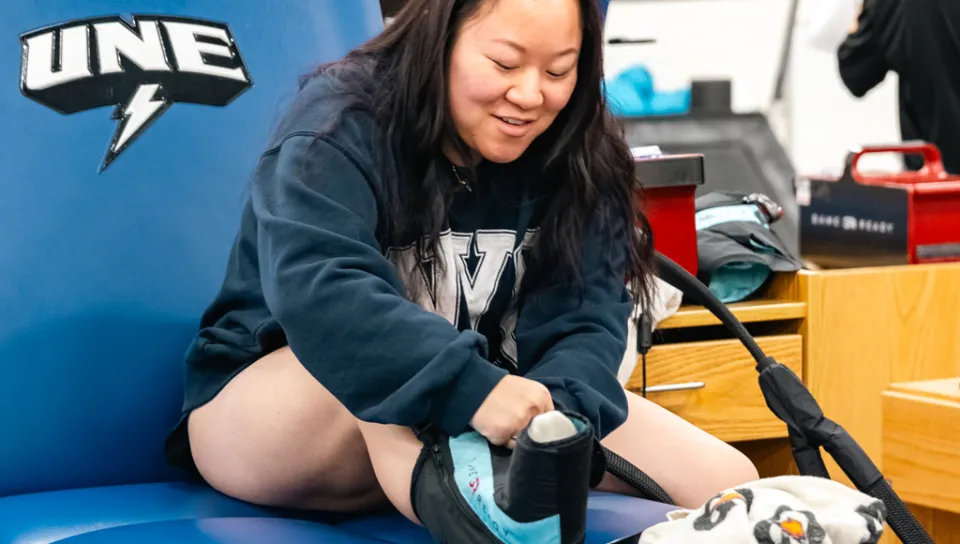
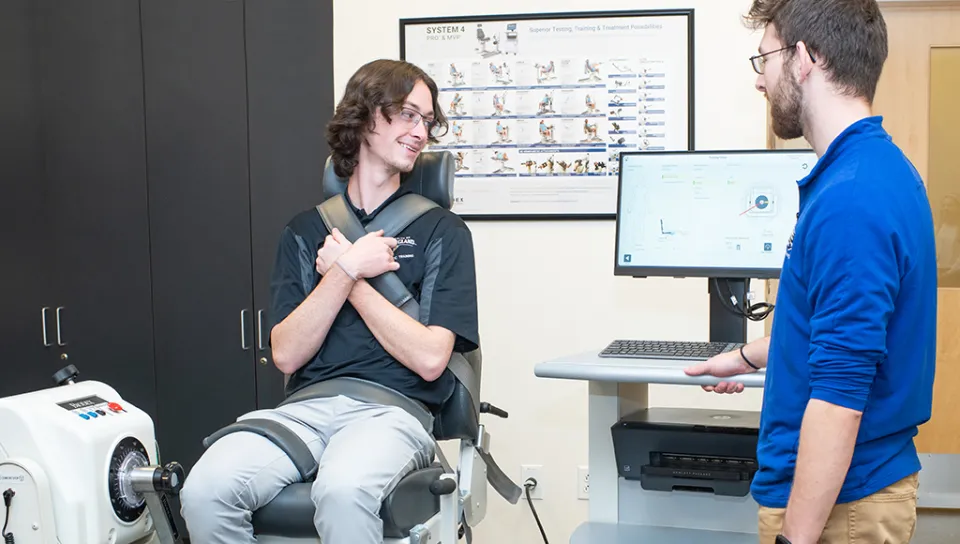
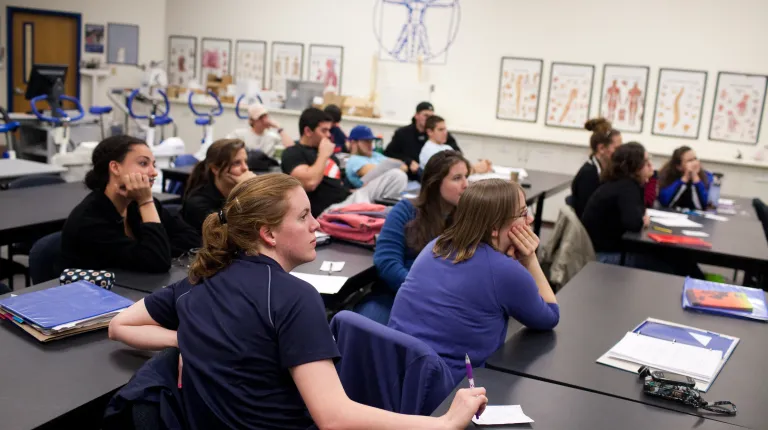
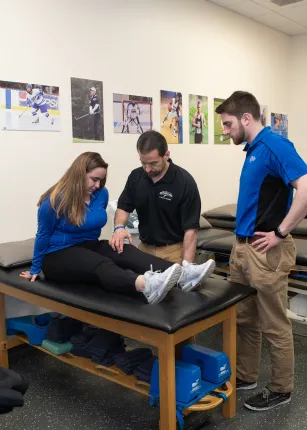
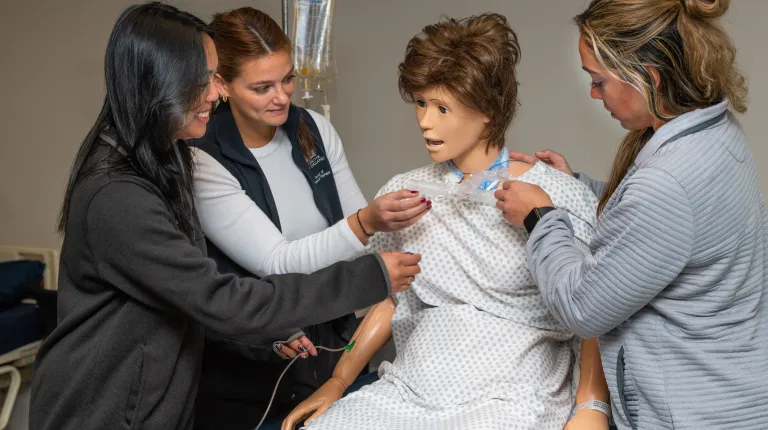
Potential Career Paths for Athletic Training Grads
Through your coursework, labs, clinical field experiences, and internships, you will be well on your way to an exciting career in athletic training. Athletic trainers are employed by physicians’ offices and sports teams and in military settings.
You may also work in related fields, including:
- Strength Coaching
- Injury Prevention
- Performing Arts/Dance Medicine
- Public Safety
- Occupational Health
Our AT graduates have landed jobs with major league franchises, such as:
- Boston Red Sox (MLB)
- Atlanta Hawks (NBA)
- Connecticut Sun (WNBA)
Athletic Training in Action at the 2022 Winter Olympics
Alumni Spotlight
Zander Kosmala went from graduating from UNE to landing a job as the head athletic trainer for an ANL team in just 4 years.
Athletic Training Facilities
As an Applied Exercise Science or Athletic Training major, you enjoy extensive modern facilities for the study of exercise and sport performance. In addition to the discipline-specific equipment and training spaces in the Harold Alfond Forum and Campus Center you also benefit from the cutting-edge computer resources, modern labs, and classrooms UNE has to offer.
The Alfond Forum
The Harold Alfond Forum, which opened in 2012, includes a 105,000-square-foot athletics complex featuring: an ice hockey rink with 900 seats; a basketball court with 1,200 seats; classroom space; a fitness center; and multi-purpose indoor practice courts that can also be used for performances and other events, with a combined seating capacity of 3,000. It also houses the Athletic Training and Applied Exercise Science programs, which have custom-designed teaching and laboratory spaces.
Take a virtual tour of Alfond Forum
The Campus Center
Opened in 1989, the 55,000-square foot Campus Center houses a sports complex that includes a 25-yard/six-lane handicapped-accessible swimming pool, an eight-person hot tub, and a fully-equipped fitness center with two racquetball courts and a free weight area. It also contains a 12,100-square-foot gym with a 1/12-mile balcony track, showers, a sauna, and locker rooms. The Campus Center is also home to BodyWISE, a UNE and community-at-large resource designed especially for people who have specific physical performance objectives, ranging from rehabilitating physical limitations to enhancing peak athletic performance. BodyWISE is an extension of UNE's educational mission and serves as a clinical training program for exercise and sport performance students as well as students in other allied health professions programs.
Take a virtual tour of the Campus Center
The Harold and Bibby Alfond Center for Health Sciences
The Harold and Bibby Alfond Center for Health Sciences is a brand-new, four-story facility that features a 240-seat tiered lecture hall, a health center with 20 fully equipped exam rooms for patient simulations, and a gross anatomy lab is used by medical, health professions, and Exercise and Sport Performance students.
Motion Analysis Lab
The Motion Analysis Lab on UNE's Portland Campus allows you to observe and measure human motion that cannot be observed with the naked eye, and to quantify the forces in the joints and neuromuscular and muscle systems.
The research you do in this technologically-advanced 1500-square-foot learning space allows you to apply the theoretical knowledge you’ve gained in the classroom to projects investigating such crucial matters to your field as better understanding the laws of sports biomechanics, or the most effective approaches to ACL rehabilitation.
Interprofessional Simulation and Innovation Center
As Athletic Training or Applied Exercise Science student, you utilize our Interprofessional Simulation and Innovation Center to apply the knowledge you gain in the classroom to realistic clinical situations before putting actual patients at risk.
Guided by skilled instructors, you participate in simulations specifically designed to enhance your clinical aptitudes. Simulations allow you to test your skills in evaluating a patient in an emergency situation or to individualize patient care for a variety of medical conditions. Rather than just hearing about and reading about difficult or unusual cases, you experience them by treating our high fidelity patient simulators and patient actors in scenarios that mimic real life.
Take a Tour of Our Facilities
Complete Research in your Athletic Training master’s
Apply your knowledge outside the classroom and clinical experiences through research rooted in athletic training. As a student in our M.S.A.T. program, you will have the opportunity to participate in research through one of our many state-of-the-art research laboratories in the Harold Alfond Forum. Our students have had the opportunity to work with world-class researchers in areas such as the prevention, recognition, and management of sport-related concussion; upper- and lower-extremity isokinetic strength assessment; body composition and bone density analysis; metabolic function; and the biomechanical analysis of human movement.
Athletic Training Studies: Team-Based Learning
When students from different health professions disciplines learn with, from, and about each other to better understand different professional roles and expertise, great things can happen. In UNE’s M.S.A.T. program, you will be studying alongside students from other programs, including the Doctor of Osteopathic Medicine and Doctor of Dental Medicine program, gaining the skills to collaborate and lead in today’s team-based care. UNE is proud to be the only institution in New England that is part of the National Center for Interprofessional Education and Practice’s prestigious Innovation Network.
You also have the opportunity to apply this collaborative participation toward your Interprofessional Honors Distinction.
Hear what our alumni have to say about the Interprofessional education at UNE
Meet UNE M.S.A.T. Students
Study Athletic Training on The Coast of Maine
As an M.S.A.T. student, you will study primarily on UNE’s scenic Biddeford Campus, less than 100 miles from Boston and where the waters of the Saco River flow into the Atlantic Ocean. Downtown Biddeford is a 10-minute drive from campus, and UNE’s Portland Campus for the Health Sciences is 30 minutes away.
Recently named the youngest city in Maine, Biddeford and its twin city, Saco, boast up-and-coming energy and community. With the transformation of the old Biddeford/Saco mills into restaurants, breweries, housing, fitness facilities, salons, and retailers, there is something for everyone.
Take a Virtual Tour of Our Biddeford Campus
Who can apply to the Master of Science in Athletic Training?
To apply to our AT degree program, you must have a bachelor’s degree from a U.S. regionally accredited institution, or international equivalent.
All applicants must apply through the Athletic Training Centralized Application Service (ATCAS).
Financial Aid At UNE
Finance your education through loans, grants, and scholarships. We are committed to making our physician assistant degree program as affordable as possible.
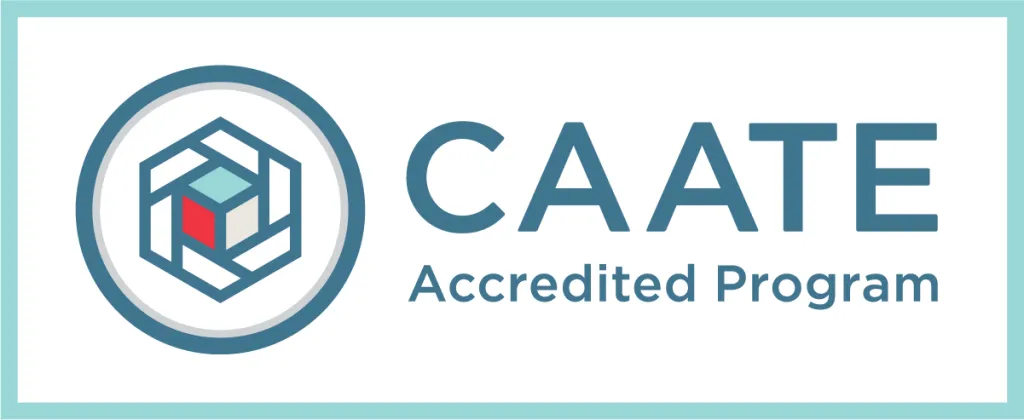
Accreditation
The University of New England Athletic Training program is accredited by the Commission on Accreditation of Athletic Training Education (CAATE).
Athletic Training Program FAQ
What is an athletic training degree?
An athletic training degree program combines the study of exercise science with the practices of preventing, managing, and rehabilitating injuries. Many students who are considering a degree in sports medicine, sports performance, kinesiology, or exercise science may actually be thinking of an athletic training degree.
Athletic training is a designated academic major or its graduate equivalent, recognized and accredited by the Commission on Accreditation of Athletic Training Education (CAATE). The minimum entry-level professional degree for athletic trainers is now a master's degree. Upon finishing a CAATE-accredited athletic training education program, students become eligible for national certification by successfully passing the Board of Certification, Inc. (BOC) examination.
UNE in Maine offers a CAATE-accredited Master of Science in Athletic Training (M.S.A.T.) degree program for those with a Bachelor of Science (B.S.) degree who meet all prerequisites. This is a two-year (24-month) program with classes and hands-on learning in our state-of-the-art facilities.
Learn more about UNE’s Master Of Science In Athletic Training (M.S.A.T.) degree program
A unique feature in UNE’s Athletic Training degree program is that it also offers an Athletic Training 3+2 Program allowing students to earn a Bachelor of Science (B.S.) in Health Sciences as well as an M.S. in Athletic Training in five years. This program blends health sciences with the skills to prevent, manage, and rehabilitate injuries in athletics and orthopedics, making you an expert in enhancing both individual and team wellness.
Is an athletic trainer the same thing as a personal trainer?
Athletic trainers are not the same thing as personal trainers. Athletic trainers are health care providers dedicated to the well-being of athletes, requiring master’s-level studies, along with required certifications. Forty-nine states and the District of Columbia require athletic trainers to hold the Board of Certification credential of “Athletic Trainer Certified” (ATC).
Personal trainers are not health care providers, they are fitness coaches. This career category has less regulation, fewer established requirements, and does not require a college degree. Personal trainers do occasionally work with athletes, but they perform a very different role than athletic trainers.
Learn more about UNE’s Master Of Science In Athletic Training (M.S.A.T.) degree program
What can I do with an athletic training degree?
An athletic training degree equips students with the essential knowledge and skills to enter the field as athletic trainers or pursue various related health care professions. Additional career paths include sports coaching, exercise physiologists, physician assistants (PA), or occupational therapists. Some of these career paths involve additional study or degrees.
Through coursework, labs, clinical field experiences, and internships, UNE students are well on their way to an exciting career in athletic training. Athletic trainers are employed by physicians’ offices and sports teams and in military settings. You may also work in related fields, including strength coaching, injury prevention, performing arts/dance medicine, public safety, and occupational health.
UNE graduates with an M.S.A.T. degree have landed jobs with major league franchises, such as the Boston Red Sox (MLB), Atlanta Hawks (NBA), and Connecticut Sun (WNBA). Our Academic and Career Advising Center is here to help you reach your academic and career goals.
How much does an athletic trainer make?
According to the National Athletic Trainers’ Association’s most recent national salary survey data (2021), the average salary for an AT with a master’s degree is $60,512. An athletic trainer’s salary is impacted by your location, education, and experience. The U.S. Bureau of Labor Statistics (BLS) predicts a 14 percent growth in employment for athletic trainers from 2022 to 2032, much faster than the average for all occupations. An increase in salary is expected to follow this trend.
How long is an athletic training program?
Entry-level athletic training now requires a master's degree. This means that athletic training students need a bachelor's degree, followed by a master’s degree in athletic training to enter the profession. It takes approximately six years to complete both a traditional bachelor's (four years) and master's degree (two years).
UNE in Maine offers an Athletic Training 3+2 Program, sometimes called an "accelerated" master's degree. This allows students to earn a Bachelor of Science (B.S.) in Health Sciences and an M.S. in Athletic Training in just five years.
What are the best colleges for athletic training?
When evaluating which college or university has the best athletic training program for you, consider the following categories and qualifications.
Faculty
Research the faculty at the schools you are interested in. Evaluate whether expert athletic training faculty will guide you through a two-year journey of classes and hands-on learning in state-of-the-art facilities.
UNE in Maine currently has five full-time faculty members who also have the ATC® credential. Additionally, we have more than 30 preceptors that supervise our students during clinical rotations around the country.
Average class size for coursework in the Pre-professional Phase of the Athletic Training program (first three years) is 30. This number typically reduces to 15 in the Professional Phase.
Meet Athletic Training faculty members at UNE
Curriculum
When looking for an Athletic Training degree program, make sure the graduate program is accredited by the Commission on Accreditation of Athletic Training Education (CAATE).
UNE’s Athletic Training master’s degree program is accredited by the Commission on Accreditation of Athletic Training Education (CAATE). Upon completion, students become eligible for national certification by successfully completing the Board of Certification, Inc. (BOC) examination.
Learn more about UNE’s BOC outcomes for our Athletic Training program
UNE’s Athletic Training curriculum combines the study of anatomy and other health-related sciences with the art of preventing, managing, and rehabilitating athletic and orthopedic injuries.
Learn more about UNE’s Athletic Training curriculum
Clinical experience is a crucial part of your UNE education. We've broadened our affiliations to include traditional and evolving settings for athletic trainers. In your last year, you can engage in immersive clinical experiences in either the fall or spring semester that can be custom-tailored to match your career goals.
Learn more about UNE’s clinical affiliations and clinical preceptors on our program’s page
UNE in Maine offers research opportunities rooted in athletic training. These include the following:
- Collaborate with leading researchers on topics like sports-related concussion, isokinetic strength assessment, body composition, bone density, metabolic function, and biomechanical analysis of human movement at the Harold Alfond Forum.
- The ability to partner with clinicians and researchers through programs like the Maine Concussion Management Initiative.
Career goals
Do some research and find out what graduates of each athletic training program you are considering do with their careers. Also, check and see if the school supports you and your career goals.
UNE’s Athletic Training master’s degree program in Maine prepares you for a fascinating, successful career in athletic training. Through your coursework, labs, clinical field experiences, and internships, you will be well on your way to an exciting career in athletic training. UNE graduates go on to work with sports teams, in physician’s practices, and beyond.
Learn more about UNE’s BOC outcomes for our Athletic Training program
Academic and career advising is available to all graduate students at UNE, no matter which program you choose. Career Advising provides a mix of career and personal interest exploration, resume and cover letter help, and support in transitioning to employment. We also organize yearly career fairs and act as a bridge between campus communities and local employers.
Learn more about Career Advising at UNE
Learning environment
Where you decide to complete your Athletic Training master’s degree program is based on the facilities, collaborative opportunities and whether you can see yourself as a member of the student body.
At UNE, it’s all about team-based learning. In UNE’s M.S.A.T. program you will be studying alongside students from other programs, including the Doctor of Osteopathic Medicine and Doctor of Dental Medicine program, gaining the skills to collaborate and lead in today’s interprofessional health care model.
Here at UNE in Maine, learning happens in state-of-the-art teaching and research laboratories. These include:
- The Harold Alfond Forum features a 105,000-square-foot athletics complex with an ice hockey rink, a basketball court, classroom space, a fitness center, and multi-purpose indoor practice courts.
- The Campus Center houses a sports complex, including a 25-yard/six-lane handicapped-accessible swimming pool, a hot tub, and a fully-equipped fitness center, along with a 12,100-square-foot gym, racquetball courts, and a free weight area. It is also home to BodyWISE, a resource for specific physical performance objectives and a clinical training program.
- The Harold Alfond Center for Health Sciences, located at the center of the Biddeford campus, is a three-story building with labs and lecture halls, placing UNE at the national forefront of health and life sciences education.
- The Motion Analysis Lab enables observation and measurement of human motion that cannot be seen with the naked eye, allowing you to apply theoretical knowledge to projects investigating crucial matters in your field.
- As an Athletic Training student, you use the Interprofessional Simulation and Innovation Center to apply classroom knowledge to realistic clinical situations, testing your skills in evaluating patients and individualizing care for various medical conditions through simulations with high-fidelity patient simulators and actors.
As an M.S.A.T. student, you'll primarily study at UNE's scenic Biddeford Campus, located less than 100 miles from Boston, where the beautiful Saco River flows directly into the Atlantic Ocean. Downtown Biddeford is a 10-minute drive, and UNE's Portland campus is 30 minutes away.
Learn more about UNE’s campuses and how you can visit us
Financial aid
Financial aid for graduate school and professional programs includes grants, scholarships, fellowships, assistantships and loans. Explore how the Athletic Training program at your chosen school can help you with financing your education.
Getting a graduate or professional degree is a big financial decision. UNE recognizes that you want a university that provides lasting value and a solid return on your investment. UNE’s Student Financial Services Office works with graduate students to help you find the best way to finance a UNE education. We can’t wait to meet you.
Learn more about graduate and professional student financial services at UNE
